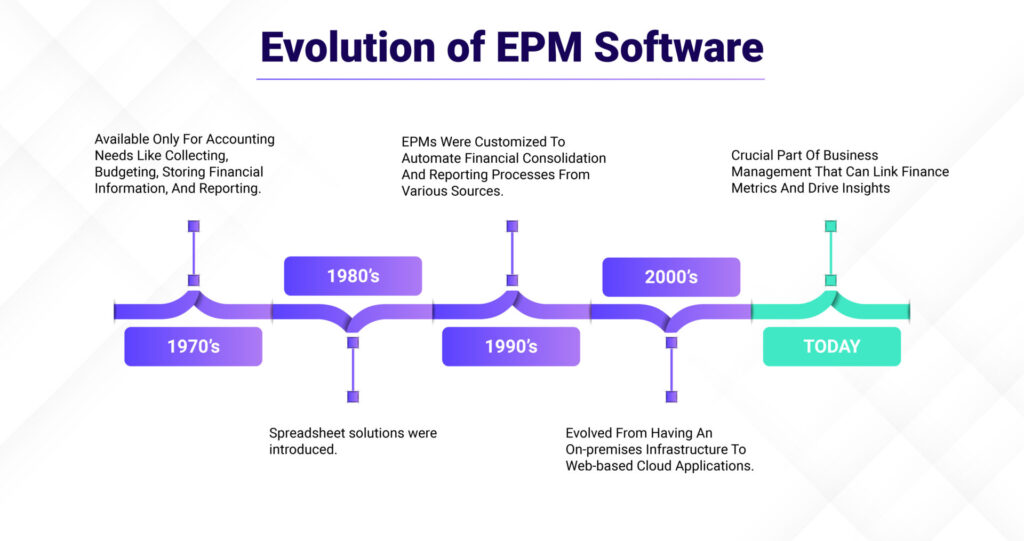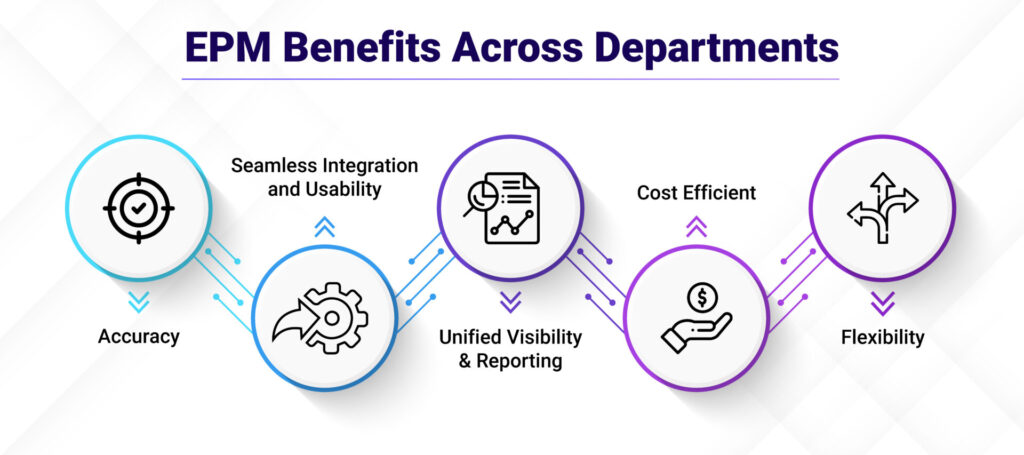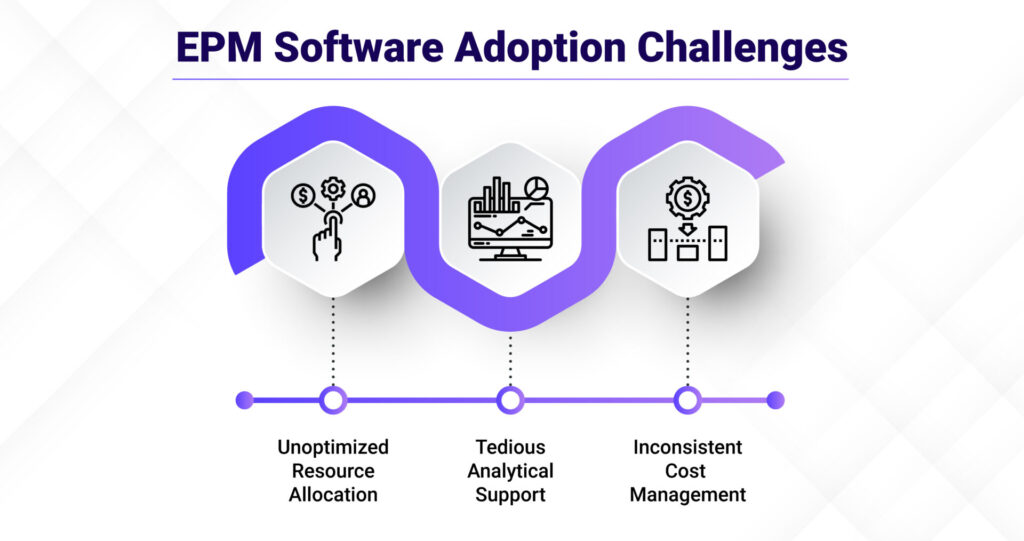To stay ahead in today’s competitive market, businesses must think of new ways to operate, like technology innovation that can incorporate all the essential business operations and enable utmost business efficiency. That is where Modern Enterprise Performance Management (EPM) systems fit right into the picture.
What is EPM?
EPM is a framework of technical and functional processes encapsulating planning, measuring, and optimizing business outcomes.
EPMs, or what they also call Corporate Performance Management (CPM), Business Performance Management (BPM), or Financial Planning & Analysis (FP&A), signify enterprise-wide applications that executive leaders and finance managers mainly use. EPM is designed to assist executive leaders in linking their business strategies to the planning and executing them through performance management of business verticals – finance, sales, marketing, manufacturing, and other line-of-business. How? By maintaining critical operations and helping the managers control revenue and manage resources.
Evolution of EPM

Even before the concept of EPM was to be determined, EPM was managed on spreadsheets, meetings, phone calls, discussions, etc. In 1970, the first EPM solution was made available only for accounting needs like collecting, budgeting, storing financial information, and reporting.
Slowly, through the advent of e-mails, spreadsheets could be shared further, and EPMs were customized to automate financial consolidation and reporting processes from various sources. Since then, EPM platforms have evolved from having an on-premises infrastructure to web-based cloud applications.
EPMs are a crucial part of business management that can link finance metrics and drive insights so leaders and managers can build business strategies and execute them accordingly. Going beyond just the role of data manipulation, modern EPMs integrate next-gen technologies like AI and ML that enable robust decision-making. Even departments such as HR, Sales, Marketing, and IT use EPM for operational planning, budgeting, and reporting.
What is the role of EPMs in fast-growing businesses?
Today’s modern EPM systems are cloud-based with advanced features like cross-functioning of business operations. With EPM making the business processes much smoother, organizations can direct the workforce towards focusing on growth and core business value addition.
An EPM solution describes enterprise management by covering the following management processes:
● Budgeting, planning, forecasting
● Devising a model through analysis and reporting
● Consolidated view of results from each team/department
● Performance analysis
KPIs like sales, revenue generation, cost overhead, and operational costs are considered while developing EPM solutions for a company.
So, what role does EPM play in identifying optimization potential in different business functions?
Enterprise Performance Management was typically used for Finance or Controlling. But thanks to faster implementation of automated planning and forecasting processes, they are also becoming more and more useful for other departments. EPMs can facilitate –

● Accuracy – A good EPM solution empowers businesses by enabling accurate forecasting, leading to clear goals. It allows monitoring of financial and operational results in real-time on all detailed and summarized levels.
● Seamless Integration and Usability – EPM software can be smoothly integrated with other business-critical applications like ERPs. EPMs are easy to operate and adopt and give intuitive insights for teams with a simple and optimal user experience. Managers do not have to invest heavy time in training or learning. EPMs easily integrate into business functions like HR, Sales, and Marketing and drive intelligent models that can help identify business outcomes.
● Unified Visibility & Reporting – Modern EPM can add tremendous value by converting data into information and providing a consolidated view where you can understand the drivers of business outcomes.
● Cost Efficient – Cloud-based EPM applications are a boon for organizations. Especially because they significantly lower Operational Expenses (OpEx) and Capital Expenses (CapEx). This is because no physical infrastructure investment is required, and the maintenance cost is much more affordable than on-prem maintenance costs.
● Flexibility – The greatest of all is that modern cloud-based SaaS EPMs can provide robustness and flexibility of modeling as and how your business scales.
All said, where there’s a reduction of IT dependence, certain challenges are posed while embracing any technology. Let’s look at the challenges that can come in the way of adopting EPM solutions.
What are the challenges of adopting EPM software?
The more relevant question is – why do we see only some companies getting it right while many are investing in the wrong place or failing? Moving to a new EPM solution is no small feat as this transition or adoption might pose implementation challenges like:

● Tedious Analytical Support – One of the main reasons for failure is the lack of coordination and planning around the integration of cloud applications. Organizations fail to plan for this as part of their requirements gathering. Later, they find that their infrastructure cannot support the storage and distribution of common data that their corporate applications require. Another example is the management and movement of data. The sheer volume of data and its constant management can make it impossible to ensure that the data being analyzed is accurate.
● Inconsistent Cost Management – Determining profitability based on business dimensions like budget, products, services, channels, markets, and legal entities, is often not a simple task. It requires teams to be fully burdened with expenses and to first invest in training them to be the know-hows of technology. Combining financial and operational data is often the biggest challenge of profitability analysis when implementing an EPM solution.
Implementing EPM is crucial, but these implementation and integration challenges affect the cost management from additional rebuilds or inaccurate framework. For a deep dive into integrating cloud and on-prem EPM solutions, choose the right technology partner who can guide your enterprise application with complete analytical support.
Why choose Techwave as your EPM partner?
With digital-first strategy taking center place for businesses in their fight against economic headwinds and competitive markets, Techwave has the expertise to bring your business strategies to life using best-of-breed EPM technology. We create, develop, and integrate end-to-end iEPM strategies that put your entire IT infrastructure in one place, making managing different departments, locations, and people easier than ever.
Built on robust and secure enterprise architecture, we deliver centralized data modeling environment designed to connect teams, systems, and insights and provide a comprehensive suite of tools to create customized reporting dashboards.
We have a strong track record backed by stellar customer stories in creating world-class tech solutions that drive positive change. We focus on creating EPM solutions that lower costs, boost profits, facilitate growth and improve supply chain management, ultimately increasing performance and delivering excellent value.



